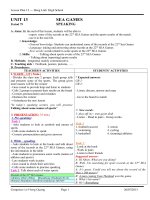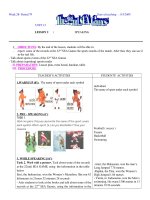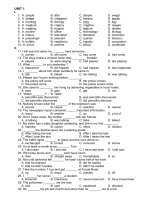ENGLISH 10 UNIT 13 SPEAKING
Bạn đang xem bản rút gọn của tài liệu. Xem và tải ngay bản đầy đủ của tài liệu tại đây (644.07 KB, 12 trang )
DA NANG,
AUGUST
22, 2017
UNIVERSITY OF FOREIGN
LANGUAGE
STUDIES
ENGLISH DEPARTMENT
--------------- ---------------
ENGLISH LANGUAGE
TEACHING
METHODOLOGY
Lesson plan
SPEAKING
English 10 – Unit 13
Group 2 – Class 1
Nguyen Hoang Thuc Anh
Tran Thi Thanh Mai
Tran Nguyen Thu
English 10
Unit 13: FILMS AND CINEMA
(Speaking)
LESSON OUTLINE
1.
2.
3.
4.
5.
-
Warm up (Thục Anh)
• Guessing game: “What films are on TV tonight?”
Pre-speaking (Thục Anh)
• Task 1:
- Practicing sample dialogue.
- Activity: Finding someone who.
While-speaking (Thanh Mai)
• Task 2: feelings/ opinions about films
- Bubble network
- Introducing structure (S + find(s) + N + Adj)
- Expressions of agreement and disagreement
- Sample dialogue
- Practicing
• Task 3: preferences for films
- Introducing structure (S + prefer(s) + N + to + N)
- Practicing
Post-speaking (Nguyên Thư)
• Task 4: Talk about the film you have seen
Consolidation
- Consolidate vocabulary to describe films and structures to
express attitudes and preferences.
Homework practice: Write a short paragraph about film.
2
English 10
Unit 13: FILMS AND CINEMA
(Speaking)
Aim: By the end of the lesson, students will be able:
- To ask and answer questions about films
- To talk about favorite kinds of film
- To express attitudes and preferences
B. Method: Communicative approach
C. Teaching aid: Textbook, handouts, slides, speakers, and markers
D. Procedures:
1. Stabilization (2’)
2. Check – up (8’)
3. New lesson (35’)
A.
Time
5’
Contents
Warm up
Activities
Game: “Which films are on TV
tonight?”
Guessing the types of the film genre
and names of these films based on the
trailers.
-
Suggested answer:
1.
2.
3.
4.
5.
Thriller (Harry Potter and the
Deathly Hallows)
Love story film (Me before you)
Science fiction film (Avatar)
Cartoon film (Spirited away)
Horror film (Anna Belle: Creation)
Answering some questions related to
the lesson.
-
Suggested questions:
1.
2.
3.
Have you ever watched these films?
Which films do you like most?
Why do you like it?
Suggested answer:
3
-
-
-
-
T divides class into 2 teams and invites
Ss to join in a game: guessing the types
of the film genre and names of these
films.
T gives Ss the rule of the game.
T plays 5 film trailers.
T asks Ss to discuss with team-mates
and raise hands to answer what the title
of the film is and what kind of that one
is.
T gives feedbacks.
The winner will be the team which has
correct answers fastest.
T asks Ss some questions, and gives
feedback.
Yes.
It’s “Me before you”.
Because it’s so romantic.
1.
2.
3.
5’
Pre- speaking
Task 1: How much do you like each
kind of film?
-
Example:
1. A: How much do you like science
fiction film?
B: I like science fiction film very
much/ Very much.
A: Do you like thriller?
B: No, I don’t like thriller at all/
Not at all.
2.
-
T shows 2 examples, which are basically
used to express one’s opinion about
kinds of film.
- T calls on some pairs to practice the
dialogue. Then T elicits from Ss which
grammar structure T uses.
-
Structure:
A:
B:
T introduces the structure. T gets Ss to
make sentences with the structure.
- T gives feedback on their sentences.
-
How much do you like --- (film)?
I like -------- very much.
Or
A:
B:
-
Do you like -------- (film)?
Yes, I like ----- but not very much/
No, I don’t like ------- at all.
Activity: Finding someone who
T delivers handout 1 to Ss and asks them
to make a group of 8 Ss.
- T requests Ss to use the structure “How
much do you like ----film?” or “Do you
like ---- film?” to ask friends in their
groups and write down their friends’
names into the suitable column “very
much/ not very much/ not at all”.
- T calls on some Ss to report their
interview and gives feedback.
-
•
Interviewing friends about how
much they like each kind of film.
•
Writing their names into the
suitable columns in handouts.
•
Reporting their interviews in front
of class.
4
8’
While speaking
*Task 2: Finding out what your friends
feel about each kind of film.
- T draws a big circle labelling
Activity 1: Network Bubble
“Adjectives for Films” and its network
- Finding out some adjectives that can be
on the board.
used to describe films
- T asks Ss to brainstorm all the adjectives
that can be used to describe films
Suggested answer:
- Then, T delivers Handout 2 to Ss. T asks
Ss to look at the adjectives in the righthand column to see if they do not know
interesting
any of the words. T explains the
meaning of new words if any.
moving
terrifying
Adjectives for Films
exciting
good fun
boring
violent
- T shows 2 examples, which are used to
Activity 2: Introducing structure
express one’s opinion about something
- Introduces the structure “S + find(s) +
or someone. Then T elicits from Ss
S.O / S.Th + Adj”, which can be used to
which grammar structure T uses.
express one’s opinion about something - T introduces the structure “S + find(s) +
S.O / S.Th + Adj”
or someone.
- T gets Ss to make sentences with the
Example:
structure.
I find Linda amusing.
- T gives feedback on their sentences.
I find war films boring.
T delivers Handout 3 to Ss.
T asks Ss to sit in groups of 4 Ss and put
Activity 3: Expressions of agreement
all the expression into the right column.
T calls on some Ss to do the task.
and disagreement
- T corrects and gives feedback
-
5
Suggested answer
Agreement
I agree with you
Yes, exactly
I can’t agree with
you anymore.
- Sure!, Exactly!,
Absolutely!
-
Disagreement
- I don’t think so
- Yes, but …
- Do you think so?
- You can’t be serious!
- You must be kidding!
T shows a sample dialogue to help Ss
practice easily.
- T divides class into 2 groups and has
them practice the dialogues.
-
Activity 4: Sample dialogue
Sample dialogue
Agree
A: What do you
think of action
films?
B: I find them
interesting.
A: Oh, I agree with
you.
Disagree
B: What’s your opinion
about horror films?
A: I find them very
terrifying.
B: I don’t quite agree
with you. I find them
very interesting.
T divides class into groups of 4 Ss and
lets them practice talking about their
thoughts of each kind of film.
- T moves around the class to help Ss if
necessary.
- T calls on some pairs asking them to
make their own dialogues.
- T gives feedback
-
7’
Activity 5: Practicing
6
*Task 3: Finding out his/her
preferences for films
-
Activity 1: Introducing structure
- Introducing structure “S + prefer(s) + N + to + N”, which can be used to talk
about one’s preferences.
Example
I prefer milk to water
I prefer cartoon films to war films
-
Sample dialogue
T shows 2 examples, which are used to
express one’s preferences for something
or someone. Then T elicits from Ss
which grammar structure T uses.
T introduces the structure “S + prefer(s)
+ N + to + N”.
T gets Ss to make sentences with the
structure.
T gives feedback on their sentences.
T shows a sample dialogue to help Ss
practice easily.
T calls on some Ss to practice the
sample dialogue
Nam: Which do you prefer, detective films or
science fiction films?
Nga: Well, it’s difficult to say. But I suppose
prefer science fiction films to detective ones.
-
Activity 2: Practicing
Suggested dialogue
-
Lan: Which do you prefer, war films
or science fiction films?
-
Mai: Personally, I prefer science
fiction films to war ones because I
find them exciting. I like The
Avengers most. I have watched it
three times.
-
7
T delivers Picture 1 to Ss and makes a
sample conversation.
T lets Ss choose some pairs of pictures
to practice asking and answering about
their preferences for films with their
partners.
T moves around the class to help Ss if
necessary.
T calls on some pairs and asks them to
make their own dialogues.
T gives feedback.
9’
Post – speaking
Task 4: Work in groups. Talk about the
film you have seen. Use the suggestions
below:
1. Where did you see it?
2. What kind of film is it?
3. What is it about?
4. Who is/ are the main character(s)?
5. How do you feel about it?
6. Why do you prefer it to other films?
-
-
-
1’
Consolidation and homework
-
-
8
T divides class into groups of 4 or 5.
T then gives handout 4.
T asks Ss to work in groups to ask and
answer questions about the film they
have seen.
T shows the suggested questions on
slides and instructs Ss how to answer
them.
Then, T asks Ss to take notes of their
friends’ stories in the handouts.
T goes around and offers help if
necessary.
T calls on some Ss to report their
friends’ stories.
T gives feedback and checks their
pronunciation.
T asks Ss to learn vocabulary to
describe films and sentence structures
to express attitudes and preferences.
Homework: Write a short paragraph
about your favorite films
APPENDIX
Handout 1
Kind of film
Very much
Not very much Not at all
Science fiction
Cartoon
Horror
Detective
Thriller
Handout 2
9
Handout 3
Kinds of films
Adjectives for films
Detective films
Interesting
Science fiction films
Moving
Love story films
Good fun
Cartoon films
Violent
War films
Boring
Thrillers
Exciting
Action films
Terrifying
1.
I agree with you
2.
Yes, but …
3.
Yes, exactly
4.
Do you think so?
5.
I can’t agree with you anymore.
6.
Sure!, Exactly!, Absolutely!
7.
You can’t be serious!
8.
I don’t think so.
9.
You must be kidding!
Agreement
Disagreement
10
Handout 4
Name
Questions
Where did you
see it?
What kind of film
is it?
What is it about?
Who is/ are the
main
character(s)?
How do you feel
about it?
Why do you
prefer it to other
films?
11
Picture 1
Cartoon Films
Science Fiction Films
Horror Films
Action Films
Love Story Films
Detective Films
12









